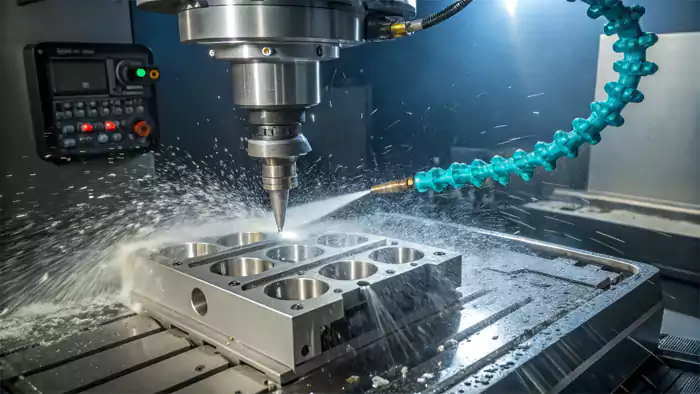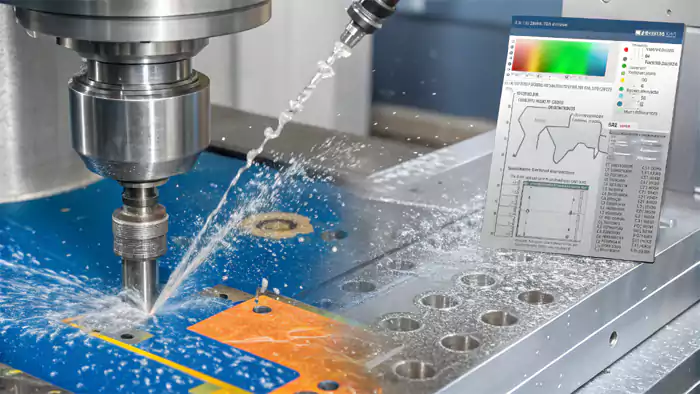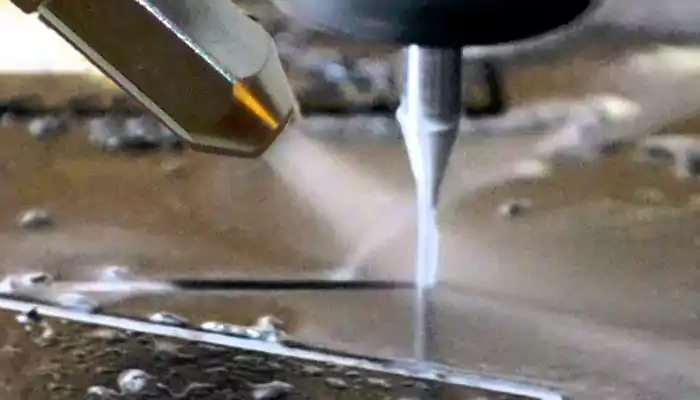Last Updated: 2025-10-20 16:19:40 Monday - Added an case study and expanded coolant management best practices based on recent shop floor experience.
Running a CNC machine dry causes tools to overheat, parts to fail, and costs to rise. After years running my own CNC machining shop, Allied Metal, I know good coolant isn't optional; it's fundamental.
CNC coolant is a special fluid used during machining. It cools the tool and workpiece, lubricates the cutting area, washes away chips, and stops rust. It's very important for long tool life and good part quality.
Think of coolant, or cutting fluid, as more than just liquid. It directly affects how well your machine works, how accurate your parts are, and even keeps things safe. Let me break down what you need to know about this vital fluid.
What Coolant is Typically Used in Machining Operations?
Choosing the wrong fluid can mess up your machine or ruin your parts. You need to know the common types to avoid simple, costly mistakes I learned to sidestep long ago.
Machining usually uses water-based coolants like soluble oils, semi-synthetics, or synthetics. Sometimes, neat oils (straight oils without water) are used for tough jobs. Each type offers different cooling and lubrication.

Understanding the main categories helps you pick the right one. Most coolants mix with water, usually at a 5% to 10% concentration. Getting this mix right is really important for performance. Here's a look at the common types I use in my machining shop:
Comparing Common CNC Coolant Types
| Coolant Type | Main Ingredients | Appearance (Mixed) | Key Benefit | Common Use |
|---|---|---|---|---|
| Soluble Oils1 | Mineral Oil, Emulsifiers, Water | Milky | Good Lubrication | General steel, cast iron machining |
| Semi-Synthetics2 | Mineral Oil, Synthetics, Water | Translucent | Balanced Lube & Cooling | Aluminum, steel, wider applications |
| Synthetics3 | Chemical Compounds, Water (No Oil) | Transparent | Excellent Cooling, Clean | Grinding, high-speed ferrous machining |
| Neat Oils | Mineral or Vegetable Oil (No Water) | Oily | Maximum Lubrication | Tough materials (stainless), threading |
Soluble oils are workhorses, providing good lubrication. Synthetics run clean and cool very well, great for grinding. Semi-synthetics offer a good middle ground, which is why we use them a lot at Allied Metal for various jobs, especially aluminum. Neat oils are for the really tough cuts where lubrication is everything.
Real-World Application: Titanium Aerospace Bracket Production
Here's a case from our shop that shows how coolant selection directly impacts machining results and costs:
We recently faced challenges machining titanium brackets for an aerospace client. The production manager was experiencing premature tool failure and poor surface finish despite using premium tooling.
Part Specifications:
- Material: Ti-6Al-4V (Grade 5 Titanium)
- Operation: 5-axis milling of complex structural brackets
- Tooling: Solid carbide end mills, 6mm diameter
- Target: 50 parts per tool life, 32 μin Ra surface finish
- Current Performance: 12-15 parts per tool, 63+ μin Ra finish
Coolant Analysis & Solution:
Our quality team conducted a thorough coolant analysis:
Before Optimization:
- Coolant: General-purpose semi-synthetic at 8% concentration
- Tool Life: 12-15 parts (45 minutes cutting time)
- Surface Finish: 63-125 μin Ra
- Chip Evacuation: Poor - frequent recutting of chips
- Machine Downtime: 25% for tool changes and cleanup
After Optimization:
- Coolant: High-performance synthetic with extreme pressure additives
- Concentration: 12% (optimized for titanium)
- Tool Life: 48-52 parts (180+ minutes cutting time)
- Surface Finish: 25-32 μin Ra (75% improvement)
- Chip Evacuation: Excellent - clean workpiece area
- Machine Utilization: Improved to 92%
Production Impact:
- Tooling Costs: Reduced by 68% ($4,200 monthly savings)
- Scrap Rate: Dropped from 8% to 1.5%
- Production Output: Increased by 31%
- Coolant Life: Extended from 3 to 6 months between changes
"The right coolant transformed our titanium machining from a constant battle to a smooth, profitable operation. We're now achieving aerospace-quality finishes consistently." - CNC Programmer
What Are the Key Ingredients Making Up CNC Coolant?
Have you ever dealt with smelly coolant or rusty parts? Knowing what's inside the fluid helps you fix problems and pick the best coolant, avoiding issues I've faced myself.
CNC coolant mainly contains water (for cooling), lubricants (oils/polymers), emulsifiers (to mix oil/water), corrosion inhibitors (stops rust), biocides (kills bacteria/fungi), and anti-foam agents.

Each part does a specific job. Water is the main heat remover4. Lubricants, like mineral oil or synthetic esters, cut down friction. Emulsifiers keep oil and water mixed properly, especially in soluble and semi-synthetic types. Corrosion inhibitors5 are vital – I've seen unprotected parts rust overnight! They protect the workpiece and the machine tool. Biocides stop bacteria and fungus growth, which cause bad smells, coolant breakdown, and potential health issues. We had a bad batch once that turned nasty quickly because the biocide was insufficient. Anti-foam agents prevent bubbles from interfering with coolant flow. The mix of these ingredients decides if the coolant is better for cooling, lubricating, or gives a balance of both.
How Do You Choose the Right Coolant for Your Machine and Material?
So many coolant options exist, making the choice feel complicated. Picking the wrong one means wasted money and time, something every shop owner wants to avoid.
Choose coolant based on the material you're cutting (like steel, aluminum, titanium) and the job (milling, turning, grinding). Match the coolant's strengths—better cooling or better lubrication—to what the job needs most.

Making the right choice involves matching the fluid to the task. Here's a simple guide based on my experience machining different materials:
Simple Coolant Selection Guide
| Material / Operation | Recommended Coolant Type(s) | Reason |
|---|---|---|
| General Steel Machining | Soluble Oil, Semi-Synthetic | Needs good balance of lubrication and cooling |
| Aluminum Machining | Semi-Synthetic, Synthetic | Needs good cooling, avoid staining, good finish |
| Stainless Steel/Titanium | Semi-Synthetic, Neat Oil | Needs high lubrication for difficult materials |
| Cast Iron Machining | Synthetic, Semi-Synthetic | Needs good cooling, allows fine particles to settle |
| Grinding Operations | Synthetic | Needs the best cooling and must run clean |
| Heavy Tapping/Threading | Soluble Oil, Neat Oil | Needs maximum lubrication for tool life |
Other things matter too. How long do you need the coolant to last in the tank (sump life6)? Does it separate out unwanted oils (tramp oil rejection7)? Is it easy for your team to work with? In my CNC machining shop, we regularly check the coolant concentration using a refractometer8 and test the pH level. This maintenance ensures the coolant works its best and lasts longer.
Coolant Management Best Practices from the Shop Floor
After managing coolant systems for thousands of machining hours, here are the practices that deliver the best results:
1. Daily Concentration Checks
- Use a refractometer calibrated for your specific coolant
- Maintain concentration within ±1% of manufacturer recommendation
- Record readings to identify trends and catch problems early
- Adjust concentration immediately when out of spec
2. Weekly Maintenance Routine
- Check and clean coolant filters and strainers
- Remove tramp oil using skimmers or coalescers
- Inspect for bacterial growth (slimy residue, foul odors)
- Test pH levels - ideal range is typically 8.5-9.5
3. Monthly System Cleaning
- Complete sump cleaning and coolant replacement if needed
- Inspect pumps, nozzles, and delivery systems
- Check for coolant separation or emulsion breakdown
- Document maintenance for quality control records
4. Material-Specific Coolant Strategies
- Aluminum Parts: Use synthetic coolants to prevent staining and discoloration
- Stainless Steel: Higher concentration (10-12%) for better lubrication
- Exotic Alloys: Specialty coolants with extreme pressure additives
- High-Volume Production: Central coolant systems with automated monitoring
5. Environmental & Safety Considerations
- Implement proper coolant recycling and disposal procedures
- Use mist collectors for employee health protection
- Provide PPE for handling concentrated coolants
- Train operators on proper coolant mixing and handling
"Proper coolant management isn't just maintenance - it's a competitive advantage that directly impacts part quality, tooling costs, and machine reliability in custom CNC machining services." - Shop Floor Manager
Are There Any Safe Substitutes for CNC Coolant in an Emergency?
Running out of coolant mid-job is a major headache. You might have to stop work or risk breaking tools. Knowing temporary fixes can help, but they have big drawbacks.
Real CNC coolant is always best. In a pinch, compressed air (for chip removal), plain water (briefly, with risks), or Minimum Quantity Lubrication (MQL) systems can be used cautiously in specific, limited situations.

Let me be very clear: these are not great replacements for proper flood coolant in most machining. Plain water cools a bit but offers zero lubrication and will cause rust very fast. I'd only consider it for a few minutes in an absolute emergency on materials that don't rust easily. Compressed air mainly just blows chips away; it doesn't cool much or lubricate at all. It's okay for some plastics or maybe cast iron where wet coolant makes a mess. Minimum Quantity Lubrication (MQL) is different. It uses a tiny spray of special oil mixed with air. MQL is a specific technique, often good for aluminum, that uses very little fluid. It needs special equipment and isn't a simple swap for flood coolant when you're taking heavy cuts or generating lots of heat. For most tough jobs, nothing truly replaces well-maintained CNC coolant.
Conclusion
CNC coolant is vital. It cools, lubricates, clears chips, and stops rust. Choosing the right type and keeping it in good condition is key for tool life, part accuracy, and machine health.
Footnotes:
-
Explore the advantages of Soluble Oils for effective lubrication in CNC machining processes. ↩
-
Learn how Semi-Synthetics provide a balance of lubrication and cooling for various materials. ↩
-
Discover the benefits of Synthetics for superior cooling and cleanliness in high-speed machining. ↩
-
Understanding the role of water in coolant systems can enhance your knowledge of effective cooling methods in machining processes. ↩
-
Learn about the significance of corrosion inhibitors to prevent rust and extend the life of machinery and tools. ↩
-
Understanding sump life is crucial for maintaining optimal coolant performance and longevity in machining operations. ↩
-
Learn about tramp oil rejection to improve coolant efficiency and reduce contamination in your machining processes. ↩
-
Using a refractometer correctly can enhance coolant management, ensuring better performance and cost savings in your shop. ↩


Hola Bono777! I signed up to give it all me and the site is looking good. Hope the luck is on my side this time! ¡Saludos! bono777